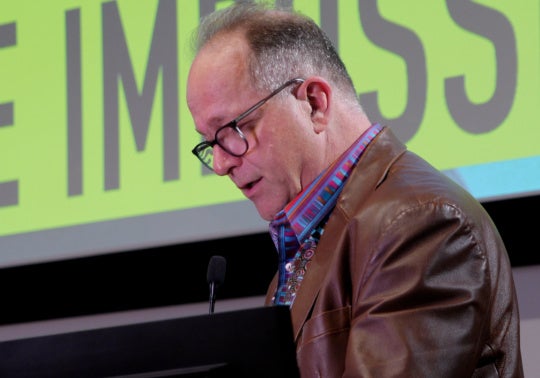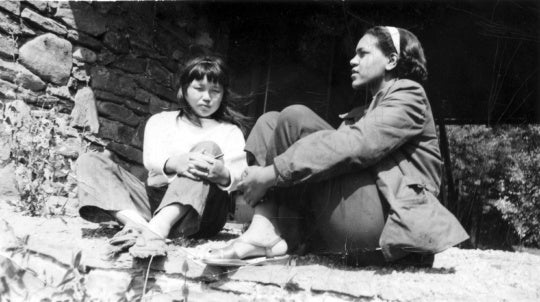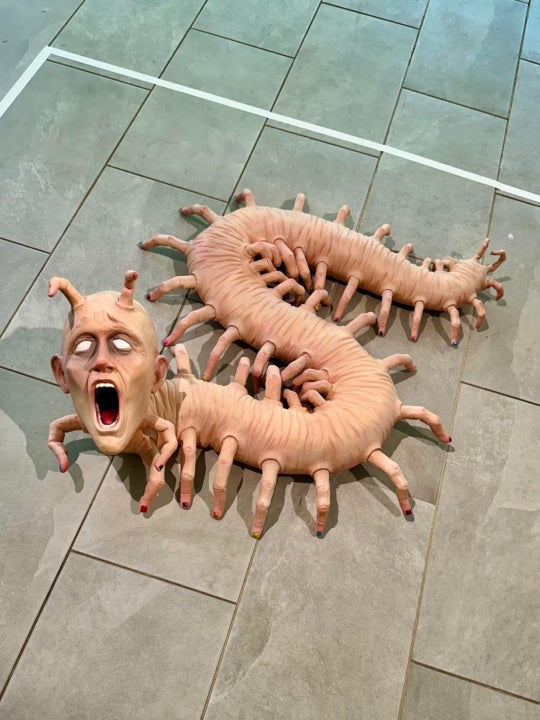
More Love: Art, Politics, and Sharing since the 1990s, which recently closed at the Ackland Museum of Art in Chapel Hill, North Carolina, surveys the ways in which contemporary artists use love as a political force [February 1-March 31, 2013]. Love is defined loosely to incorporate sharing, communication, gifts, and acts of service; in short, acts that breed understanding and intimacy between all parties involved. This contemplative show, organized by consulting curator Claire Schneider, cleverly juxtaposes artworks to expose layers of meaning in well-known pieces, and provides a revealing second-look at some of the best art of the past few decades.
More Love is an exhibition that quickly establishes itself in your consciousness and maintains that hold long after you’ve left the museum. In the coatroom, I was startled by disembodied voices coming from the wall of lockers as part of Julianne Swartz’s Affirmation (2006-13). In this audio installation, 72 people respond to the question, “What could someone say to you that would make you feel completely loved (acknowledged, understood, respected, cared for, attractive, embraced, supported, safe, cherished…)?” The recorded voices state these desired affirmations as if to enact them, effectively implicating the museum-goer as recipient of this praise and enveloping him or her in a feeling of connectivity. This introduction to the exhibition emphasizes a powerful aspect of the artworks involved; all tap into an important emotional register in order to evoke understanding of politically complicated concepts.
Take the conceptual and physical proximity of works by Antonio Vega Macotela and Gregory Sale, which serve to undermine authoritarian structures in radically different ways. The drawings from Macotela’s Time Exchange series (2006-11) depict trades the artist made with inmates in a prison in Mexico City. Macotela would perform a service for the inmate while the inmate would simultaneously make a drawing. In Time Exchange 82, Macotela danced to a specific song with the inmate’s mother while the inmate drew the steps involved in that dance. While the drawing itself is a complicated jumble of footprints that implies an energetic dance, it’s the individual footprints that evoke the most pathos. We can imagine the act of drawing each one serving as visualization of Macotela’s foot hitting the ground with the implication that, by drawing in tandem, the inmate is guiding or even engaging in the movement himself. But the exchange is unsatisfactory; the inmate cannot see his mother’s smile or feel her hand in his. Instead, this begets a wistful moment of imagined freedom.

In contrast to the collaboration and wistfulness of the Time Exchange series is Sale’s It’s not just black and white: a mediated reflection (2011-12), which emphasizes the strict boundaries and hierarchies of prison systems. This video work features documentation of a social project Sale conducted in Arizona—a state with one of the highest incarceration rates in the country—in collaboration with 14 inmates, corrections officers, other artists, and museum staff. Uniformed inmates paint black and white stripes on the wall alongside jail guards, a sheriff, museum personnel, and so on. Though the project brings these diverse groups into the same space to conduct the same act—as opposed to the distant and inexact simultaneity of Macotela’s project—the distinctions in uniform and the inherent subordinate position of the inmates creates a palpable and disturbing tension. The inmates’ uniforms oppressively mimic the stripes they are painting, and their silence (as they work alongside officers) reminds us that, although they share a task at that moment, their statuses are vastly opposed. It’s a discomfiting video to watch, which is Sale’s point: It’s not just black and white forces the viewer to confront the inequalities of the prison system and, by inserting it into the context of a museum, reevaluate the conditions of prison life we consider necessary. It’s not just black and white and the Time Exchanges approach the problematic condition of prisons from distinctly different angles; Marcoles shows the slim hopes of freedom for the individual within, while Sale emphasizes the overbearing structural aspects of the penal system.

Other pairings in More Love reveal new meaning in well-known works. Felix Gonzales-Torres’s Untitled (Portrait of Ross in L.A.) (1991)—a 175-pound pile of candy corresponding to his now-deceased partner’s original weight before his gradual deterioration due to AIDS—fills a corner adjacent to Jim Hodges’s Untitled, 1992, a drawing made by licking paper and pressing blue ball-point pen drawings onto the wet page to transfer the images. The candy in Torres’s work is free to take, and as museum-goers avail themselves of the sweets, the pile will eventually diminish—just as Gonzales-Torres’s partner did over the course of his illness. Though the candy is wrapped in shiny, cheerfully-colored paper, the piece conveys a bittersweet mixture of grief for Torres’s loss as well as the odd thrill of getting to touch art in a museum, and receive the candy as if a gift from the artist. Hodges’s drawing, which uses bodily fluids to confront fears surrounding AIDS, brings out a similar feature in Torres’s artwork. As one sucks the candy, the sugar combines with saliva to create syrup in the mouth, which is a pleasing sensory experience but must also be considered in light of AIDS-crisis anxieties. The Eucharistic aspect of Gonzales-Torres’s candy is made all the more contemplative for this juxtaposition.


Image Credit: © Jim Hodges, Courtesy of the artist and Gladstone Gallery, New York and Brussels
These are just a few of the connections inspired by More Love. This complicated yet cohesive exhibition elegantly navigates the wide range of issues posed by the 48 works included in the show, creating an introspective, if at times overwhelming, experience. Though it’s impossible to fully absorb its impact in one visit, this is More Love’s achievement, not its downfall. This is not a show that offers easy resolution before you reach the door; viewers will carry the implications of these works back into the world where many of these concerns are still devastatingly relevant.
More Love will travel to the Cheekwood in Nashville, Tennessee later this year.




